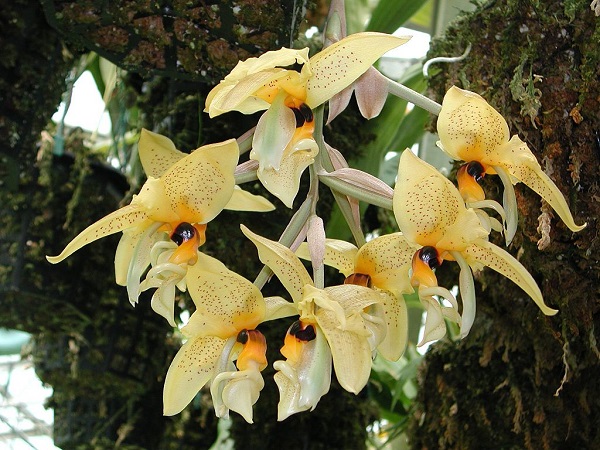To many of us who started growing Orchids for the first time, we commonly referred to the plants by a common or familiar name. The two most popular are “Moth Orchids” and “Lady Slipper” Orchids. To most, that’s good enough, but to become a serious grower and collector one must eventually come to grips with their correct Latin Botanical names.
For example, in the case of a hybrid Cattleya: Laliocattleya Mildred Rives “Orchidglade” AM/AOS, tells us four things about this plant:
- It is a member of the genus Laliocattleya
- It is a hybrid (or grex) named Mildred Rives
- Orchidglade is its clonal name
- And it has received an Award of Merit (AM) from the American Orchid Society, based upon a 100-point scale system.
To investigate an Orchid name even further, pick up your plants label. Typically, the name will consist of at least two words. The first word is the name of the genus (or the plural form; genera). Genus names or genera are Latin names and always begin with a capital letter. While Botanists abbreviate plants a certain way, horticulturists often use short abbreviations, such as Den. for Dendrobium or Phal. for Phalaenopsis.
Within each of the groups noted above (or genus) there can be dozens, if not hundreds, of “variations” on a theme. Taxonomists (those who actually classify plants) with respect to Orchids, recognize these species by giving them individual names called “epithets”. A specific epithet may indicate its place of origin, such as “guatamalensis”, from Guatemala or might be named after the person who discovered the plant such as “besseae”, for Libby Besseae, a certain characteristic of the plant, such as “glauca” meaning gray-blue or even in honor of a certain person.
So, together with the genus name and its epithet, we have now created the species name that will often reveal quite a bit about the plant or flower itself. For example, Sophronitis coccinea, tells us its flower is red (coccinea, Latin for red) or Brassavola glauca, tell us the plants leaf is bluish-gray (glaucous, Latin for gray).

Featured Orchid
Under the category, of “weird and bizarre” is the genera Stanhopea. You must grow at least one of these plants (or one of it’s relatives like Coryanthes) to make your collection complete. Why? Glad you asked.
The alien looking flowers of these epiphytes are some of nature’s most complex, bizarre, and stunning flowers on earth. The plants are robust, warm growers with large, pleated leaves. Blooming once a year, typically in the Spring, the inflorescence will emerge from the bottom of the plant and therefore must be grown suspended in a slatted basket or wire basket for the spike to emerge. The flowers with intricate, complex structures and mechanisms for pollination are powerfully fragrant, brilliantly spotted, and colored but last for only perhaps two or maybe three days. Upon close inspection one can notice “channeled” walkways for insect pollination or “buckets” of a watery solution. In some species, if the sensitive stigma of plant is barely nudged, the spring like action of the stigma will propel its pollen for several feet, utterly amazing. Try some, you won’t be disappointed!
Tom Capranica has been a hobby collector and hybridizer of Orchids for over 20 years, and an active member of the American Orchid Society for about the same length of time. He grows his Orchids in a 450 sq. ft. climate-controlled greenhouse, containing over 300 plants of various genera, primarily Cattleya.
Related Articles & Free Email Newsletter Sign Up
4 Popular Orchid Propagation Methods
Threatening Cattleyas and Phalaenopsis to Bloom
To Pot or Not to Pot an Orchid, That is the Question!




Comment here